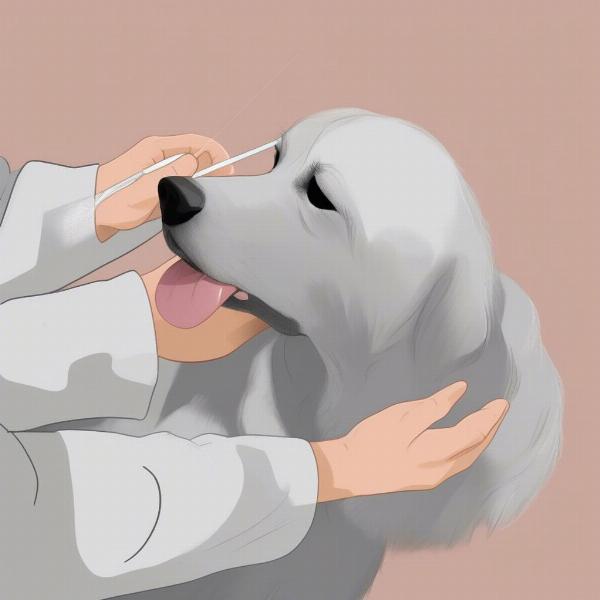Anti-lick strips for dogs are becoming increasingly popular as a way to manage excessive licking, which can lead to skin irritation, infection, and delayed wound healing. Whether your dog is recovering from surgery, battling allergies, or simply a compulsive licker, understanding how these strips work, their benefits, and potential drawbacks is crucial. This guide will provide you with all the information you need to make an informed decision about using anti-lick strips for your furry friend.
Understanding the Need for Anti-Lick Strips
Why do dogs lick excessively? Several reasons contribute to this behavior, including allergies, hot spots, dry skin, injuries, and even boredom or anxiety. While occasional licking is normal, persistent licking can exacerbate existing skin conditions and create new problems. This is where anti-lick strips come into play. They act as a physical barrier, preventing the dog from directly contacting the affected area with their tongue.
Benefits of Using Anti-Lick Strips
Anti-lick strips offer numerous advantages for both dogs and their owners. They can:
- Promote faster healing: By preventing licking, these strips allow wounds and hot spots to heal without constant irritation.
- Reduce infection risk: Licking introduces bacteria into wounds, increasing the risk of infection. Anti-lick strips minimize this risk.
- Break the lick cycle: Excessive licking can become a compulsive behavior. The strips help break this cycle by preventing the dog from engaging in the activity.
- Provide a drug-free alternative: Unlike medicated creams or sprays, anti-lick strips offer a non-pharmacological approach to managing licking.
- Offer comfort and protection: The strips can provide a comfortable barrier against irritants, allowing the skin to recover.
Types of Anti-Lick Strips
Several types of anti-lick strips are available, each with its own features and benefits:
- Fabric strips: These are often made from soft, breathable materials and are secured with Velcro or similar closures.
- Inflatable collars: These provide a cushioned barrier around the dog’s head, preventing them from reaching most areas of their body.
- Plastic cones (Elizabethan collars): These are the traditional cone-shaped collars that restrict head movement.
How to Choose the Right Anti-Lick Strip for Your Dog
Choosing the right strip depends on several factors, including:
- Location of the wound/irritation: For leg injuries, a fabric strip might be sufficient. For wounds on the body, an inflatable collar or cone may be necessary.
- Dog’s size and temperament: A smaller, calmer dog might tolerate a fabric strip, while a larger, more active dog might require a more secure option like an inflatable collar.
- Veterinarian’s recommendation: Always consult your veterinarian for guidance on the most suitable type of anti-lick strip for your dog’s specific situation.
Applying and Caring for Anti-Lick Strips
Proper application and care are essential for the effectiveness of anti-lick strips. Follow the manufacturer’s instructions carefully. Ensure the strip is snug but not too tight. Check regularly for any signs of irritation or discomfort.
 Correctly Applying an Anti-Lick Strip to a Dog
Correctly Applying an Anti-Lick Strip to a Dog
Are There Any Side Effects?
While generally safe, anti-lick strips can sometimes cause minor skin irritation if not applied correctly or if the dog is allergic to the material. Monitor your dog closely for any signs of redness, swelling, or discomfort.
Conclusion
Anti-lick strips are a valuable tool in managing excessive licking in dogs. By choosing the right type of strip and following proper application and care guidelines, you can help your dog heal faster and more comfortably. Remember to consult with your veterinarian for personalized advice. Using anti-lick strips can significantly contribute to your dog’s overall well-being and prevent further complications from excessive licking.
FAQ
- How long should my dog wear an anti-lick strip? This depends on the reason for its use. Consult your veterinarian for specific guidance.
- Can my dog eat and drink with an anti-lick strip on? Yes, most anti-lick strips are designed to allow for normal eating and drinking.
- What if my dog keeps trying to remove the strip? You may need to try a different type of strip or consult your veterinarian for alternative solutions.
- Are anti-lick strips reusable? Some fabric strips are washable and reusable. Disposable options are also available.
- Can I make my own anti-lick strip? While possible, it’s generally recommended to use commercially available strips for safety and effectiveness.
- My dog seems depressed while wearing the strip, what should I do? Provide extra attention, comfort, and positive reinforcement to help your dog adjust.
- Where can I buy anti-lick strips? They are available at most pet stores, veterinary clinics, and online retailers.
Related Articles on ILM Dog
ILM Dog is your trusted resource for expert advice and practical information on dog care and wellbeing. We cover a range of topics from breed selection and health care to training, nutrition, grooming, and product recommendations. Our aim is to empower dog owners worldwide with the knowledge they need to provide the best possible care for their canine companions. Whether you’re a seasoned dog owner or just starting your journey, ILM Dog is here to support you every step of the way. For personalized advice or to learn more about our services, contact us at [email protected] or call +44 20-3965-8624. We’re dedicated to helping you build a strong, healthy, and happy relationship with your furry friend. Visit ILM Dog today!